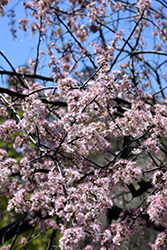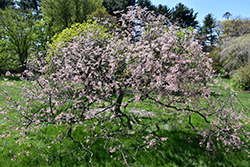It's all about ...
plants

Height: 15 feet
Spread: 15 feet
Sunlight:
![]()
![]()
Hardiness Zone: 5a
Other Names: Sloe Plum
Description:
This native large shrub or small tree lights up in spring with clusters of white flowers that mature to soft pink before the leaves; small, dark purple fruit in late summer; may form thickets over time; good for landscape borders
Ornamental Features
Allegheny Plum is smothered in stunning clusters of lightly-scented white flowers along the branches in early spring before the leaves. It has attractive forest green deciduous foliage which emerges light green in spring. The pointy leaves are highly ornamental and turn an outstanding gold in the fall. The fruits are showy deep purple drupes which fade to black over time, which are displayed in mid summer. The fruit can be messy if allowed to drop on the lawn or walkways, and may require occasional clean-up. The furrowed brown bark and brick red branches add an interesting dimension to the landscape.
This plant is primarily grown as an ornamental, but it's also valued for its edible qualities. The small round tart fruit is most often used in the following ways:
- Preserves
Landscape Attributes
Allegheny Plum is a multi-stemmed deciduous shrub with an upright spreading habit of growth. Its average texture blends into the landscape, but can be balanced by one or two finer or coarser trees or shrubs for an effective composition.
This shrub will require occasional maintenance and upkeep, and is best pruned in late winter once the threat of extreme cold has passed. It is a good choice for attracting birds to your yard. Gardeners should be aware of the following characteristic(s) that may warrant special consideration;
- Suckering
- Spiny
Allegheny Plum is recommended for the following landscape applications;
- Mass Planting
- Hedges/Screening
- Naturalizing And Woodland Gardens
Planting & Growing
Allegheny Plum will grow to be about 15 feet tall at maturity, with a spread of 15 feet. It has a low canopy with a typical clearance of 1 foot from the ground, and is suitable for planting under power lines. It grows at a medium rate, and under ideal conditions can be expected to live for approximately 30 years.
This shrub does best in full sun to partial shade. It is quite adaptable, prefering to grow in average to wet conditions, and will even tolerate some standing water. It is particular about its soil conditions, with a strong preference for sandy, acidic soils. It is somewhat tolerant of urban pollution. This species is native to parts of North America.
This plant is not reliably hardy in our region, and certain restrictions may apply; contact the store for more information.

